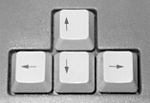Arrow key
As arrow keys , and cursor keys , the four to be computer keyboards arranged usually in a separate block keys indicated with arrow imprint. They are found on almost all key- oriented input devices . Usually there are exactly four arrows for up (up), down (down), left and right like on a compass or like a winner's podium . There are seldom fewer or more arrows available.
Arrangement and occurrence
The four standard arrow keys are usually located between the main keypad and numeric keypad in the shape of an upside-down Ts. These are:
- ← - Left
- ↑ - upwards (upwards)
- → - right
- ↓ - downwards (downwards)
In most cases, there are also arrow keys in the number block next to the right on the keys 4(left), 8(up), 6(right) and 2(down) as a second assignment , which can be used after switching off the Num function with the Num key . Sometimes there are also diagonal arrow keys in the arrow keypad.
The first keyboard that had arrow keys in today's layout was LK201 (see web links) by DEC , which was produced from 1982.
use
Arrow keys are used to move the cursor . They can be used for any type of text input. They are also helpful in being able to quickly select the desired menu item in menu-supported displays. In video games , a character is often moved through the world using arrow keys. There is often a controller specially designed for such games , or a joystick that can be attached to the arrow keys on the keyboard. The function of controlling the figure is now largely done by the WASD control pad. When performing creative tasks such as web design , 3D modeling or image editing , arrow keys are almost indispensable in order to move, scale or rotate objects. In C ++ or C programs, the arrow keys can be queried using getch () with ←= 75, ↑= 72, →= 77 and ↓= 80.
| Esc | F1 | F2 | F3 | F4 | F5 | F6 | F7 | F8 | F9 | F10 | F11 | F12 |
Print S-Dep |
roll |
pause break |
Numeric keypad : | ||||||||

|
Insert | Pos1 | Image ↑ | Num | / | * | - | |||||||||||||||||
| Dist | The End | Image ↓ | 7th | 8th | 9 | + | ||||||||||||||||||
| 4th | 5 | 6th | ||||||||||||||||||||||
| ↑ | 1 | 2 | 3 | Enter | ||||||||||||||||||||
| ← | ↓ | → | 0 | , | ||||||||||||||||||||

